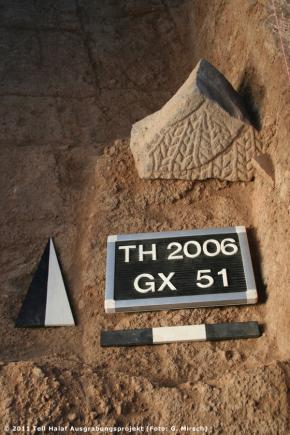Research goalsProf. Dr. Mirko NovákThe following aims of research are to be solved by the new excavations: Investigating the Prehistoric Occupation
One of the foremost goals of the new investigations is the establishment of a clear stratigraphic sequence of the prehistoric settlement phases, thereby putting the relative chronology of the Neolithic and Chalcolithic ages in the area, that is, for the time span from the late 7th to the end of the 4th millennium B.C. on a broader, more solid base. Chronology of the Iron Age
The findings known so far confirm that Tell Halaf was occupied throughout all periods of the Iron Age: from the Early Iron Age via the time of the Aramaean principality and the Neo-Assyrian period to Seleucid-Parthian times. One of the goals of the current research is to establish a continuous ceramic sequence of the Iron Age. Acculturation Processes of the Aramaeans
The acculturation processes of the Aramaean founders of the town, who had newly immigrated into a region that had been the centre of the empire of Mitanni in the Late Bronze Age and, later, became an Assyrian province, are still to be clarified. Urban Structure and Spatial Layout of the Citadel
Numerous questions about the urban structure and the development of the settlement of Guzana are still open, like the question after the function of the citadel’s subdivision in two separate areas.
An investigation of the way in which the Hilani and the «Nordost-Palast» were integrated into the overall structure of the citadel is also necessary. Related therewith is the question whether Kapara’s pictorial programme was restricted to the ornamentation of the Hilani and the «Skorpionentor» or if more buildings decorated with relief orthostats existed.
The possible existence of cult buildings from pre-Assyrian times is an important question that needs further investigation as well. Transformation of the Aramaean Town into the Capital of an Assyrian Province
It is also of interest which processes were active in the integration of Guzana into the Assyrian empire and what the «Assyrianization» of the Aramaeans looked like. Town-history in Late Babylonian, Achaemenid and Hellenistic Times
For a long time, the history of the settlement and of the region after the collapse of the Assyrian empire has not been scrutinized. For this reason, the investigation of the transitions from the Neo-Assyrian over the Achaemenid and finally to the Hellenistic periods promises to be of great interest. Referring to that, research on the acculturation processes at ancient Guzana during the Hellenistic period promises to be fruitful, as well. How strong were the impulses from the Seleucid west on the indigenous culture in Guzana? To which extent can similar processes be observed at the other mentioned sites of the region and how can they be traced? (Translation: B. Finkbeiner / A. Sollee / B. Sollee) |






